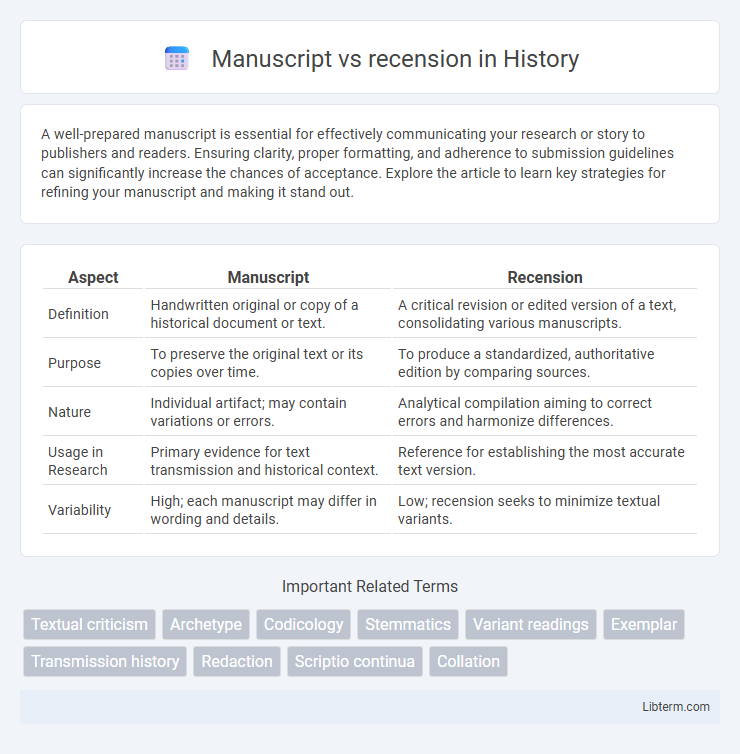A well-prepared manuscript is essential for effectively communicating your research or story to publishers and readers. Ensuring clarity, proper formatting, and adherence to submission guidelines can significantly increase the chances of acceptance. Explore the article to learn key strategies for refining your manuscript and making it stand out.
Table of Comparison
| Aspect | Manuscript | Recension |
|---|---|---|
| Definition | Handwritten original or copy of a historical document or text. | A critical revision or edited version of a text, consolidating various manuscripts. |
| Purpose | To preserve the original text or its copies over time. | To produce a standardized, authoritative edition by comparing sources. |
| Nature | Individual artifact; may contain variations or errors. | Analytical compilation aiming to correct errors and harmonize differences. |
| Usage in Research | Primary evidence for text transmission and historical context. | Reference for establishing the most accurate text version. |
| Variability | High; each manuscript may differ in wording and details. | Low; recension seeks to minimize textual variants. |
Introduction to Manuscripts and Recensions
Manuscripts are original handwritten texts that serve as the primary sources for historical, literary, and religious studies, preserving the author's authentic content and style. Recensions refer to edited versions of these manuscripts, often revised through systematic comparison and correction to create standardized or improved texts. Understanding the distinction between manuscripts and recensions is crucial for textual criticism, as it involves analyzing variations and establishing the most accurate representation of the original work.
Defining Manuscripts: Origins and Purpose
Manuscripts are original handwritten documents that date back to ancient civilizations, serving as primary sources for historical, religious, and literary works. Their purpose was to preserve and transmit knowledge before the invention of the printing press, often created by scribes in monasteries or scholarly institutions. These artifacts provide critical insights into linguistic, cultural, and textual traditions, forming the foundation for textual criticism and the study of recensions.
Understanding Recensions: Meaning and Significance
A recension is a critical revision or edited version of a manuscript, reflecting efforts to establish a more accurate or authoritative text by comparing multiple manuscript copies. Understanding recensions is vital in textual criticism, as they reveal how texts have evolved through various edits, omissions, or additions made by scribes or scholars over time. The significance of recensions lies in their ability to provide insight into historical transmission, cultural context, and the intended meaning of ancient or classical works.
Key Differences Between Manuscript and Recension
A manuscript is an original handwritten or typed document representing an author's work, while a recension is a critical revision or edited version of that manuscript, often involving textual corrections or updates. Manuscripts preserve the initial content and style, whereas recensions reflect scholarly efforts to standardize or improve accuracy based on comparative analysis of multiple sources. The key difference lies in origin: manuscripts are primary texts, and recensions are secondary, refined editions aimed at enhancing textual integrity.
The Role of Manuscripts in Textual Transmission
Manuscripts play a crucial role in textual transmission by preserving original texts through handwritten copies, often serving as primary sources for later recensions. Each manuscript can exhibit unique variants, reflecting scribal practices, regional influences, and historical contexts, which are essential for reconstructing the text's evolution. Analyzing diverse manuscripts allows scholars to identify alterations and establish critical editions that represent the most authentic form of a work.
The Impact of Recensions on Literary Works
Recensions significantly influence literary works by introducing variations that affect interpretation, authenticity, and textual integrity. Manuscripts often serve as the primary sources, but recensions reflect editorial decisions, cultural shifts, and transmission errors that shape the evolution of a text over time. Understanding recensions is crucial for scholars to reconstruct original meanings and trace the historical development of literary compositions.
Methods of Identifying Manuscripts and Recensions
Methods of identifying manuscripts involve analyzing physical attributes such as material, script style, and handwriting variations, alongside palaeographic and codicological techniques that assess the manuscript's age and origin. Recensions are identified by examining textual variants, dialectical differences, and editorial interventions through comparative philology and stemmatic analysis to reconstruct the manuscript's transmission history. Advanced digital tools like multispectral imaging and textual collation software enhance the precision of distinguishing between individual manuscripts and their broader recensions.
Case Studies: Famous Manuscripts and Their Recensions
Famous manuscripts such as the Codex Sinaiticus and the Dead Sea Scrolls have multiple recensions that reveal textual variations and historical transmission patterns. Detailed case studies of these manuscripts highlight how scholars compare different recensions to reconstruct original texts and understand scribal practices. Analysis of recensions in manuscripts like the Mahabharata illuminates the evolution of literary traditions and regional adaptations.
Challenges in Manuscript and Recension Studies
Manuscript and recension studies face significant challenges including textual variants, scribal errors, and the difficulty of reconstructing original texts from incomplete or corrupted sources. The complexity of discerning intentional edits from unintentional alterations complicates the establishment of authoritative versions. Preservation issues and limited access to rare manuscripts further hinder comprehensive comparative analysis essential for accurate recension.
The Importance of Manuscripts and Recensions in Modern Scholarship
Manuscripts serve as primary sources containing original texts that provide critical insights into historical, literary, and religious contexts, while recensions represent edited or revised versions reflecting textual transmission and editorial evolution. The comparison of manuscripts and recensions enables scholars to trace textual variants, establish authoritative editions, and understand the development of ideas over time. Modern scholarship relies on careful analysis of both to reconstruct accurate texts and interpret cultural and intellectual history with greater precision.
Manuscript Infographic

 libterm.com
libterm.com